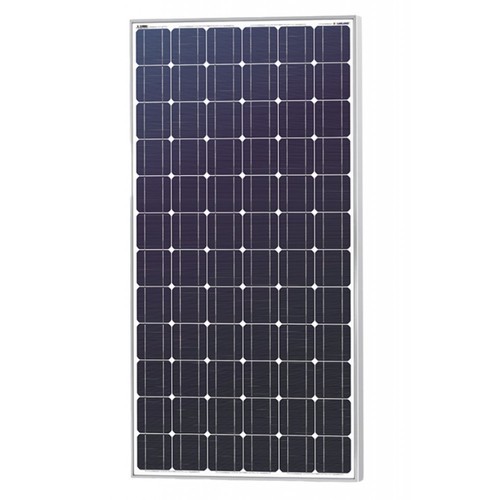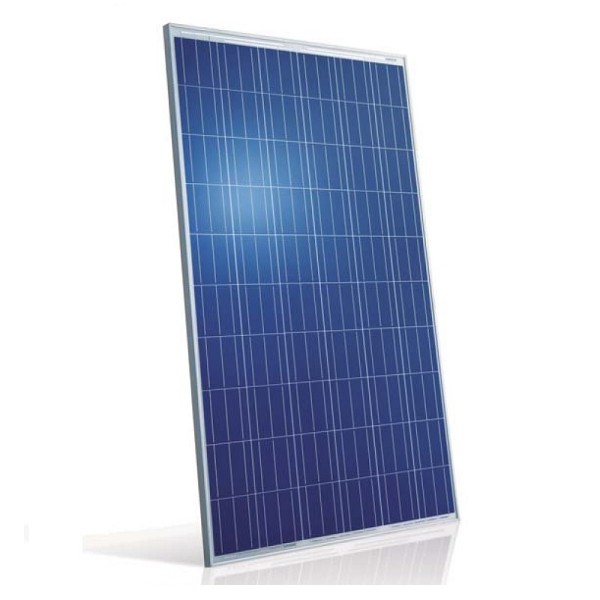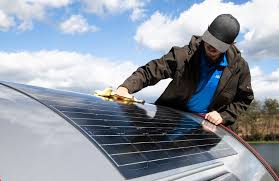Solar Panels are an assembly of photovoltaic cells mounted in a framework that uses sunlight as a source of energy to generate direct current electricity, which is converted to Alternate Current (AC) by an inverter. Most modules use either wafer-based crystalline silicon cells or thin-film cells. Below we will see the types of Panels, their key features and usability.
- Monocrystalline Solar Panels
In these panels, each solar PV cell is made of a single silicon crystal that’s why they are referred as “mono”. They are characterized by their black PV cells with rounded edges. They have a higher conversion efficiency than polycrystalline panels, i.e. they produce more units of electricity. Monocrystalline panels promises more generation so if you have limited space they work as a very good option. Also these panels are available in as high capacity like 550 Wp as compared to Polycrystalline that comes in max 350 Wp.
These solar panels are the most prominent and well-known panels used today in industry today and widely used in industries, commercial and residential installations.
Monocrystalline come in PERC Technology which is Passivated Emitter and Rear Cell. PERC is the latest technique which increases its efficiency in various ways. The PERC helps in absorbing the sunlight from the frontal area and the rear surface gets the reflected sunlight.
Altogether it boosts the efficiency from 20 to 22 percent in just a few solar panels. The PERC also advances the high temperature and low light performance which ensures a greater and continued output of power.
Key features of monocrystalline solar panels:
- They have the higher efficiency than Polycrystalline
- They require less space as each panel range from 540-650 Wp.
- They can easily work for more than 25 – 30 years.
- Give 22- 24% of efficiency rates.

- Polycrystalline Solar Panels
In these solar panels, multiple silicon fragments are moulded and blended which gives a blue colour in appearance.
Polycrystalline or Multicrystalline solar panels are solar panels that consist of several crystals (Poly) of silicon in a single PV cell
They are cheaper than monocrystalline and which makes them highly usable in various application like street lights, traffic lights, gardens, farms etc. Also where area is ample and plant size is small one should prefer going for Polycrystalline as it helps to save cost.
Key features of polycrystalline solar panels:
- They are cheaper than monocrystalline
- Have a lower heat tolerance i.e. they perform less than monocrystalline solar panels in high temperatures
- Its lifespan is affected by an increase in temperature.
- Lesser effective in low light conditions.

- Thin-Film Solar Cells or Flexible Panels
A thin-film solar cell is a second generation solar cell that is made by depositing one or more thin layers, or thin film (TF) of photovoltaic material on a substrate, such as glass, plastic or metal.
These solar panels are thin in appearance because small and thin photovoltaic cells are placed which helps in making them rigid and lightweight. It can give efficiency of 12-16% and can be installed very easily as compared to that of traditional solar panels. They are widely used on rooftops, solar farmlands, street lights and much more.
Key Features of Thin-Film solar panels:
- These panels is capable of meeting a wide range of applications where standard panels can be inconvenient to mount, such as on the curved roof, boats etc
- They are lighter in weight as they are without frame
- Thin-Film solar panels are less efficient and have lower power capacities than mono and polycrystalline solar panels
- They also require more space. Low space-efficiency also means that the costs of support structures and cables is high for this technology
- Thin-film solar panels tend to degrade faster than mono and poly solar panels thus they have a shorter warranty of about 10-15 years.
Building-integrated photovoltaics (BIPV) are solar systems that are integrated into the building envelope and part of building components such as façades, roofs or windows. Serving a dual purpose, a BIPV system is an integral component of the building skin that simultaneously converts solar energy into electricity and provides building envelope thermal insulation; noise protection; daylight illumination and also enhances aesthetics of the building.
Key Features of BIPV solar panels:
- Gives a very premium price and futuristic look to buildings.
- Can last more than 30 years.
- Reduces electricity bills.
- Saves infrastructure materials and other costs.

What panel should you choose
Confused about choosing between Poly and Mono panels and want to know which works best for you. You deserve the best of technology at an affordable rate and we are there to help you.
Here’s a quick comparison:
Monocrystalline Solar vs Polycrystalline Solar
| Monocrystalline Solar | Polycrystalline Solar |
| They have the higher efficiency than Polycrystalline | They are cheaper than monocrystalline.
Have a lower heat tolerance i.e. they perform less than monocrystalline solar panels in high temperatures |
| Monocrystalline solar panels have black-colored solar cells made of a single silicon crystal, and they usually have a higher efficiency. | Polycrystalline solar panels have blue-colored cells made of multiple silicon crystals melted together. |
| They can easily work for more than 25 – 30 years. | Its lifespan is affected by an increase in temperature |
| They require less space as each panel range from 540-650 Wp. | Lesser effective in low light conditions. |
Why Choose MSI Enterprises?
At MSI Enterprises, we provide you with affordable rooftop solar panel solutions for your offices, industries, commercial spaces and residences. Get all your solar solutions hassle-free in no given time.
Please Get In Touch With Us.




